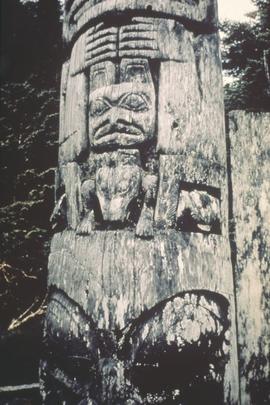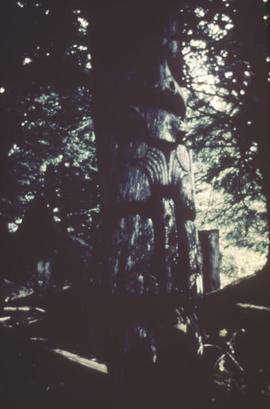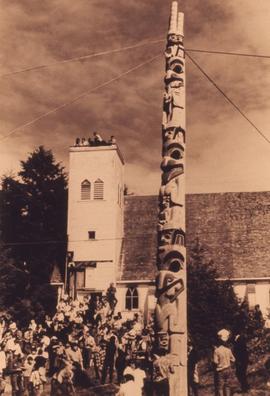- 51-01-29-a039475
- Item
Parte deHarry B. Hawthorn fonds
Image of a house post on Anthony Island, Haida Gwaii. This appears to be a post now housed at the Museum of Anthropology (museum item #A50016). This museum item is described as follows: "Totem, crescent shaped in cross section, carved in shallow and deep relief. From top to bottom: human with hands at right angles and fingertips touching. The arms are folded with the elbows resting on squared ears of figure below. Enclosed within this frame is a small human/hawk face with beak, surmounting the head, shoulders, and forepaws of an emerging bear cub. At the base is a bear from whose ears frogs look downward. The bear has curled nostrils; upturned mouth, raised forearms with five fingers folded over each palm, small human face between forearms... Stood at centre of back wall inside house called 'Raven House', belonging to the lineage of the'Sand Town People' of Raven moiety of Kunghit Haida. MacDonald lists it as house number 17... Pole standing when collected...Figures are crests belonging to the lineage of the owners of the house, the 'Sand Town People' of the Raven moiety. They may also refer to the Bear Mother myth."





![Betty Wilson, Haida & Bella Bella [Heiltsuk]](/uploads/r/null/2/e/b/2ebe83971f351b495e1cac60182d130692d3c3c5d7cbb82b0115d998be0748c0/a037543c_142.jpg)
![Betty Wilson, Haida & Bella Bella [Heiltsuk]](/uploads/r/null/5/6/4/564b91c0d3c0c0b9e953dd2f2243c812a099ad1166e184aea868cd1a30aaad07/a037544c_142.jpg)